Journal Description
Parasitologia
Parasitologia
is an international, peer-reviewed, open access journal on parasitology published quarterly online by MDPI.
- Open Access— free for readers, with article processing charges (APC) paid by authors or their institutions.
- High Visibility: indexed within Scopus, AGRIS, and other databases.
- Rapid Publication: manuscripts are peer-reviewed and a first decision is provided to authors approximately 19.8 days after submission; acceptance to publication is undertaken in 5.8 days (median values for papers published in this journal in the second half of 2023).
- Recognition of Reviewers: APC discount vouchers, optional signed peer review, and reviewer names published annually in the journal.
- Parasitologia is a companion journal of Pathogens.
Latest Articles
Data on Demodex Ectoparasite Infestation in Patients Attending an Outpatient Clinic in Greece
Parasitologia 2024, 4(2), 129-136; https://doi.org/10.3390/parasitologia4020011 (registering DOI) - 26 Apr 2024
Abstract
►
Show Figures
Demodex mites are acari, common ectoparasites of humans and other mammalian pilosebaceous units. Demodicosis occurs when mites overpopulate the skin, causing several skin disorders. Our aim was to investigate the prevalence of demodicosis in patients with suspicious clinical features, such as cheek redness,
[...] Read more.
Demodex mites are acari, common ectoparasites of humans and other mammalian pilosebaceous units. Demodicosis occurs when mites overpopulate the skin, causing several skin disorders. Our aim was to investigate the prevalence of demodicosis in patients with suspicious clinical features, such as cheek redness, itching, and skin sensitivity, who presented at the outpatient clinic of the Andreas Syggros Dermatology Hospital in Greece. We studied 184 individuals aged between 18 and 97 years and analyzed the content of pilosebaceous units by microscopy to determine the density of Demodex mites. Samples were evaluated as positive when Demodex spp. densities equaled or exceeded 5 mites per square cm. Sixty-six percent of the examined subjects were positive for demodicosis. The age distribution was statistically normal (p = 0.2), and the median age was 51.29 years. Seventy percent of the patients were females, and 30% were males, while 64.46% of the demodicosis-positive individuals were females, and 35.54% were males. We observed a rise in the percentage of males as the age of the patients increased. Demodicosis can be a challenging disease because it presents apart from the typical symptoms, with a variety of nonspecific symptoms mimicking other dermatological skin conditions. Therefore, it is important to investigate Demodex spp. in patients who present with common facial dermatological diseases to improve treatment results. Further studies could contribute to a better understanding of the pathogenic role of Demodex mites and how this role is affected by mite density, host sex and age.
Full article
Open AccessReview
Transmission Modelling for Human Non-Zoonotic Schistosomiasis Incorporating Vaccination: Guiding Decision- and Policymaking
by
Ursula Panzner
Parasitologia 2024, 4(2), 101-128; https://doi.org/10.3390/parasitologia4020010 - 15 Apr 2024
Abstract
Schistosomiasis, acquired by skin-penetrating cercariae of dioecious digenean schistosomes during freshwater contact, afflicts nearly 260 and 440 million people with active infections and residual morbidity, respectively. About 10 million women at reproductive age contract schistosomiasis during gestation every year. Acute schistosomiasis is characterized
[...] Read more.
Schistosomiasis, acquired by skin-penetrating cercariae of dioecious digenean schistosomes during freshwater contact, afflicts nearly 260 and 440 million people with active infections and residual morbidity, respectively. About 10 million women at reproductive age contract schistosomiasis during gestation every year. Acute schistosomiasis is characterized by pre-patent pro-inflammatory CD4+ T-helper 1 or CD4+ Th1/T-helper 17 reactivity against immature schistosomulae. Chronic schistosomiasis is dominated by post-patent anti-inflammatory CD4+ T-helper 2 reactivity against ova epitopes. Flukes co-exist in immunocompetent definitive hosts as they are capable of evading their defense mechanisms. Preventive measures should be complemented by vaccination, inducing long-term protection against transmission, infection, and disease recurrence, given the latest advancements in schistosomal vaccines. Vaccines become pivotal when considering constraints of chemotherapy, i.e., lack of protection against re-infection, and evolving resistance or reduced sensitivity. Transmission models for human non-zoonotic schistosomiasis incorporating vaccination available in PubMed, Embase and Web of Science up to 31 December 2023 are presented. Besides conceptual model differences, predictions meant to guide decision- and policymaking reveal continued worm harboring that facilitates transmission besides residual infections. In addition, increased susceptibility to re-infection and rebound morbidity, both shifted to later life stages following the intervention, are forecasted. Consequently, a vaccination schedule is pivotal that considers the optimal age for initial immunization, i.e., pre-schoolchildren or schoolchildren in a cohort-based or population-based manner, while incorporating potential non-adherers promoting ongoing transmission. Longevity over magnitude of vaccine protection to antigenic schistosomal moieties is crucial. Accounting for pre-acquired immunity from natural exposure, in utero priming in addition to herd immunity, and induced by chemotherapy is crucial. Combining, as a multi-component approach, long-term effects of vaccination with short-term effects of chemotherapy as regular repeated vaccine-linked therapy seems most promising to achieve WHO’s endpoints of transmission elimination and morbidity control.
Full article
Open AccessEditorial
Micro–Nanoplastics as Potential Carriers of Dioxins and Toxoplasma gondii in Patients with Carotid Atheromas
by
Giovanni Di Guardo
Parasitologia 2024, 4(2), 99-100; https://doi.org/10.3390/parasitologia4020009 - 14 Apr 2024
Abstract
A recent major study has shown that there is an increased risk of myocardial infarction, stroke and lethal outcomes in patients affected by carotid atheromas that contain micro-nanoplastics (MNPs) compared to subjects that do not have MNPs in their lesions [...]
Full article
Open AccessBrief Report
Evaluation of a Commercial Serum Competitive Enzyme-Linked Immunosorbent Assay for Detection of Neospora caninum-Specific Antibodies in Raw Milk of Ruminants
by
Ragab M. Fereig, Sarah A. Altwaim and Caroline F. Frey
Parasitologia 2024, 4(2), 91-98; https://doi.org/10.3390/parasitologia4020008 - 27 Mar 2024
Abstract
►▼
Show Figures
Bovine neosporosis is an infection caused by the protozoan parasite Neospora caninum and has substantial veterinary hazards. Neosporosis cannot be controlled by vaccination or chemotherapy. Thus, accurate diagnosis followed by isolation and culling of infected animals is regarded as the most efficient method
[...] Read more.
Bovine neosporosis is an infection caused by the protozoan parasite Neospora caninum and has substantial veterinary hazards. Neosporosis cannot be controlled by vaccination or chemotherapy. Thus, accurate diagnosis followed by isolation and culling of infected animals is regarded as the most efficient method of control. In vivo diagnosis often relies on serologic testing of the animals, and milk represents a non-invasive and easy-to-collect sample matrix. However, indirect enzyme-linked immunosorbent assay (ELISA) specifically designed for antibody detection in milk are sometimes not easily available and it is tempting to use ELISA kits that are originally designed for use in serum in milk samples instead. Herein, we evaluated a widely used commercial ELISA (ID Screen® Neospora caninum competition Multispecies ELISA (ID. Vet, Grabels, France)), developed for detection of N. caninum antibodies in serum samples, for its performance on milk samples. Milk samples from dairy ruminants (cows, buffaloes, sheep, and goats; n = 149) were tested in parallel with the serum ELISA and a commercial milk ELISA as a standard test (Neospora caninum Milk Competitive ELISA, ID. Vet, Grabels, France). The detected prevalence values were 28.2% (42/149), 17.4% (26/149), and 17.4% (26/149) using milk ELISA, serum ELISA, and both ELISAs, respectively. Sensitivity, specificity, positive predictive value, and negative predictive value for the serum ELISA used with milk samples were 61.9%, 100%, 100%, and 87%, respectively. The agreement and kappa value between the two ELISAs were 89.3% and 0.70, respectively, suggesting substantial agreement. High values of Pearson correlation coefficient (0.904, p ≥ 0.0001) and area under the receiver operating characteristic (ROC) curve (0.789, p ≥ 0.0001) demonstrated the high diagnostic performance of the serum ELISA in milk samples. Also, a Bland–Altman Plot and histogram describing the frequency of distribution of ELISA optical densities confirmed the high agreement of both serum and milk ELISAs. The current results revealed the high specificity but moderate sensitivity of the serum ELISA used for milk samples compared with the milk ELISA. However, the excellent positive predictive value of the serum ELISA makes it an alternative option in case of the unavailability of milk ELISAs. With this study, we provided additional evidence that a widely used serum ELISA test kit may also be used for the detection of N. caninum antibodies in milk samples.
Full article
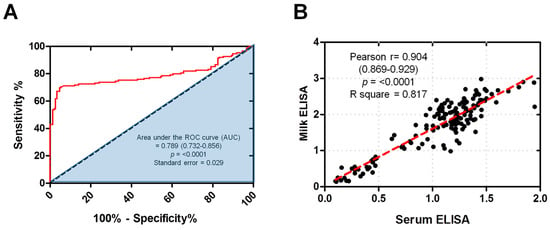
Figure 1
Open AccessReview
Hedgehogs’ Parasitology: An Updated Review on Diagnostic Methods and Treatment
by
Francisco Alfaia, Catarina Jota Baptista, Viktória Sós-Koroknai, Márton Hoitsy, Endre Sós and Luís M. Madeira de Carvalho
Parasitologia 2024, 4(1), 82-90; https://doi.org/10.3390/parasitologia4010007 - 17 Mar 2024
Abstract
The genus Erinaceus is commonly found in rescue centres across the European continent despite the reported decline in some countries. Parasite infections are frequently detected in rescued hedgehogs, leading to increased morbidity and mortality and consequently conditioning their recovery. Some of the most
[...] Read more.
The genus Erinaceus is commonly found in rescue centres across the European continent despite the reported decline in some countries. Parasite infections are frequently detected in rescued hedgehogs, leading to increased morbidity and mortality and consequently conditioning their recovery. Some of the most frequent parasites include respiratory nematodes, such as Crenosoma striatum and Capillaria spp., which may lead to important pneumonia. Moreover, some of these agents have zoonotic potential, such as Cryptosporidium spp., Sarcoptes spp., and several species of ticks and fleas, which may transmit different vector-borne pathogens. This review provides a brief guide on hedgehogs’ internal and external parasitology, as well as some suggestions for diagnosis and treatment that are relevant for wildlife veterinarians, biologists and other researchers.
Full article
Open AccessArticle
Influence of Amitraz-Based Product Characteristics on Varroa Mite Population Control
by
Gabrielle Almecija, Benjamin Poirot, Paulo Mielgo, Max Watkins and Christelle Suppo
Parasitologia 2024, 4(1), 71-81; https://doi.org/10.3390/parasitologia4010006 - 01 Mar 2024
Abstract
►▼
Show Figures
The presence of the Varroa destructor mite requires the use of acaricide treatments for honeybee colonies. Amitraz is one of the most common acaricide-active ingredients used by beekeepers. Certain Varroa mite populations have developed resistance to amitraz, thereby leading to a loss in
[...] Read more.
The presence of the Varroa destructor mite requires the use of acaricide treatments for honeybee colonies. Amitraz is one of the most common acaricide-active ingredients used by beekeepers. Certain Varroa mite populations have developed resistance to amitraz, thereby leading to a loss in the efficacy of amitraz-based treatments. Two products, Apivar and Supatraz, were applied in the same apiary in France to evaluate their efficacy. Both treatments are amitraz-based but have different galenics. Thanks to field data, a dynamic model was used to simulate the actions of Apivar and Supatraz on the mite population. We considered two parameters to compare the products as follows: the daily mortality rate and the treatment duration. In the field, the percentage of the efficacy of the two products was not significantly different, but Supatraz kills mites faster and decreases 90% of the mite infestation in 28.4 days compared with 50.9 days when using Apivar. Through modeling, we showed the daily impact of the two different products on mite population. Supatraz has a higher daily mortality rate during the first two weeks than Apivar. Supatraz requires a lower efficacy (% of varroa mites killed during all the treatment) to stabilize the varroa mite population due to its faster release of active ingredients than Apivar, thereby needing a shorter period to achieve the same result. Depending on the model, Supatraz conserves effective efficacy when used against moderately resistant mites (with mite mortality being 40–70% at the LC90) but not against highly resistant mites (with mite mortality being <40% at the LC90). These results show that the comparison of the efficacy of the two products with different characteristics (duration of treatment and daily mortality rate) should be analyzed with caution.
Full article
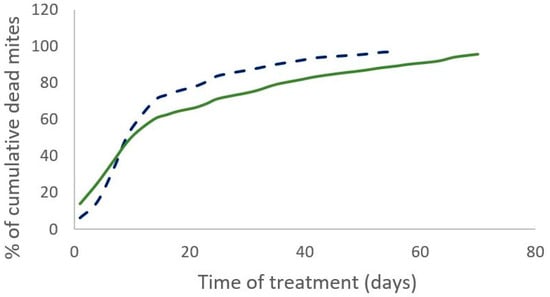
Figure 1
Open AccessArticle
Prevalence and Intensity of Sarcocystis spp. Infections in Alpine Chamois (Rupicapra r. rupicapra) in Germany
by
Steffen Rehbein and Martin Visser
Parasitologia 2024, 4(1), 61-70; https://doi.org/10.3390/parasitologia4010005 - 18 Feb 2024
Abstract
Chamois are mountain ungulates (Artiodactyla: Caprinae) which inhabit several medium- and high-altitude mountain ranges from southern Europe to the Near East. The first findings of Sarcocystis cysts in the musculature of chamois were reported in the 1970s. However, only limited work on the
[...] Read more.
Chamois are mountain ungulates (Artiodactyla: Caprinae) which inhabit several medium- and high-altitude mountain ranges from southern Europe to the Near East. The first findings of Sarcocystis cysts in the musculature of chamois were reported in the 1970s. However, only limited work on the epidemiology of sarcocystosis and the identification of the species of Sarcocystis in chamois has been carried out in the past. The present study aimed to provide, for the first time, data on the prevalence and intensity of Sarcocystis spp. Infection in native Alpine chamois using a histology examination of heart and/or diaphragm tissue samples collected from 216 chamois (40 kids [<1 year] and 176 chamois ranging up to 18 years of age). Sarcocysts were detected in either the heart or diaphragm of 167/216 chamois (77.3%), with 131 of 183 heart samples and 127 of 215 diaphragm samples testing sarcocyst-positive. Of the 181 chamois with both heart and diaphragm samples available (34 kids and 147 older animals), sarcocysts were detected in the heart and/or diaphragm of 142 animals, translating to an overall 78.5% prevalence of Sarcocystis spp. infection (95%CI 72.5–84.4%). Sarcocysts were more frequently recorded in the heart vs. diaphragm (72.4% vs. 56.4%; p = 0.0021), and diaphragm positivity was associated with heart positivity (p = 0.0001). The sarcocyst prevalence (heart and/or diaphragm) was significantly (p < 0.001) lower in the kids than in the older chamois (27.1% vs. 88.6%, respectively); however, it did not differ between the sexes, regardless of the chamois’ age (p > 0.3). The intensity of infection was generally low (<10 sarcocysts per cm2 muscle cut) in both heart-positive and diaphragm-positive animals (94.7% and 93.7%, respectively). The heart tissue yielded higher sarcocyst counts than the diaphragm tissue (p < 0.001). Both the heart and diaphragm sarcocyst counts were significantly (p < 0.001) lower in the kids than in the older chamois. Sarcocystis spp. infection was demonstrated to be prevalent in chamois in Germany, but its intensity is apparently low. Further studies are desired to identify the species of Sarcocystis parasitizing the chamois using both phenotypic and molecular characteristics.
Full article
(This article belongs to the Special Issue Sarcocystis in Domestic and Wildlife Animals)
►▼
Show Figures
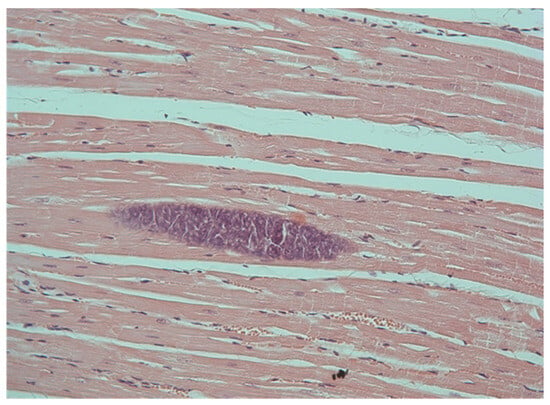
Figure 1
Open AccessArticle
A Field Study Evaluating the Effects of Diclazuril and Oregano Oil for the Prevention of Coccidiosis in Fattening Rabbits
by
Florian Lohkamp, Julia Hankel, Andreas Beineke, Josef Kamphues and Christina Strube
Parasitologia 2024, 4(1), 47-60; https://doi.org/10.3390/parasitologia4010004 - 07 Feb 2024
Abstract
►▼
Show Figures
For years, there has been an increasing interest in natural alternatives to the conventional coccidiostats applied as feed additives, which have been used for decades to prevent coccidiosis in poultry and fattening rabbits. This study aimed to compare the possible anticoccidial effects of
[...] Read more.
For years, there has been an increasing interest in natural alternatives to the conventional coccidiostats applied as feed additives, which have been used for decades to prevent coccidiosis in poultry and fattening rabbits. This study aimed to compare the possible anticoccidial effects of oregano oil to the established substance diclazuril in growing rabbits. The control group (CG) received a non-supplemented basal compound feed, to which either diclazuril (1 mg/kg; DG) or oregano oil (75 mg/kg; OG) was added. In each of the three trials, subgroups of 50 rabbits each were assigned to one of the three experimental groups (CG, DG and OG). Natural Eimeria infection was monitored weekly by fecal oocyst counts and Eimeria species identification following sporulation. Additionally, the performance parameters were determined at the middle and the end of the trials, and the deceased rabbits were subjected to necropsy. Neither oocyst excretion nor the performance parameters differed significantly between the three experimental groups. Eimeria media, Eimeria magna, Eimeria perforans and Eimeria exigua were identified as the occurring species. The highest animal losses (16.0%) occurred in the OG, while the losses were 12.7% in the DG and 12.0% in the CG. However, these differences were not statistically significant. Overall, neither diclazuril nor oregano oil was superior to the non-supplemented feed. This underlines the importance of diagnostics, as this study’s results indicate that in the absence of the highly pathogenic Eimeria species, economic rabbit rearing and fattening is achievable without the use of coccidiostats.
Full article
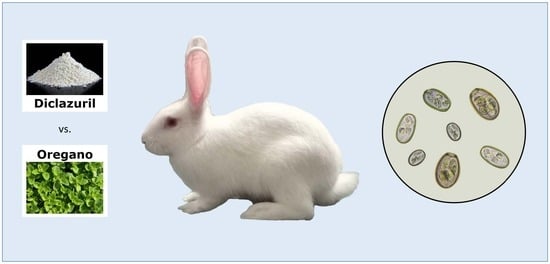
Graphical abstract
Open AccessArticle
Host Choice and Feeding Behaviours of Glossina morsitans Offspring Whose Parents Were Fed on Different Host Species
by
Filbert E. Mdee, Jeremiah Lyatuu, Eliakunda Mafie and Ladslaus L. Mnyone
Parasitologia 2024, 4(1), 38-46; https://doi.org/10.3390/parasitologia4010003 - 15 Jan 2024
Abstract
►▼
Show Figures
The success of any tsetse control program depends on the knowledge of their behaviour. This study assessed the host choice and feeding behaviours of Glossina morsitans siblings whose parents were bloodfed on rabbits, guinea pigs, rodents, and squirrels. Each individual host was placed
[...] Read more.
The success of any tsetse control program depends on the knowledge of their behaviour. This study assessed the host choice and feeding behaviours of Glossina morsitans siblings whose parents were bloodfed on rabbits, guinea pigs, rodents, and squirrels. Each individual host was placed in a screen cage, which allowed flies to enter through openings on each side. The groups of flies (20 per replicate), which were colour-marked differently based on their parents’ blood meal hosts, were released from the centre of large semi-field cage. The released flies were aspirated after 24 h and then sorted based on their location, feeding status, and parents’ blood meal. A total of 213 flies (72.95% of those recovered) were attracted to the hosts. The numbers of flies attracted to different hosts varied significantly (χ24 = 33.685, p = 0.0001): rodents (n = 80, p = 0.006), rabbits (n = 59, p = 0.331), guinea pigs (n = 49, p = 0.057), and squirrels (n = 25, p = 0.005). The numbers of flies attracted to their parent’s blood meal source varied significantly (χ212 = 56.476, p < 0.001): rabbits (n = 35, 59.32%, p < 0.001), rodents (n = 25, 31.25%, p = 0.043), and guinea pigs (n = 19, 38.78%, p = 0.45). But only 39 flies (18.31% of the total attracted) bloodfed on the hosts, including guinea pigs (n = 10, 25.64%), rodents (n = 23, 58.97%), rabbits (n = 6, 15.38%), and squirrels (n = 0, 0.0%). There was significant variation in the number of flies that fed successively across hosts (χ24 = 49.478, p < 0.001). The findings from this study confirm the presence of differential attractiveness of the hosts to flies and the so-called “Hopkins host selection principle” or “pre-imaginal conditioning”. Therefore, the study attracts the need for detailed investigation on the influence of blood meal sources on tsetse fly siblings’ behaviours across filial generations using small mammals or other large mammal species.
Full article
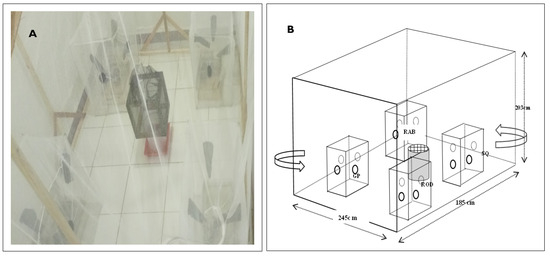
Figure 1
Open AccessReview
Amebicides against Acanthamoeba castellanii: The Impact of Organism Models Used in Amebicide Assays
by
Leonardo Fernandes Geres, Elena Sartori, João Marcos dos Santos Neves, Danilo Ciccone Miguel and Selma Giorgio
Parasitologia 2024, 4(1), 15-37; https://doi.org/10.3390/parasitologia4010002 - 01 Jan 2024
Abstract
Acanthamoeba castellanii is a free-living amoeba capable of causing keratitis in humans, with most cases related to contact lens wearers and surgical procedures. In addition, A. castellanii may cause pneumonia, granulomatous encephalitis, and skin lesions in immunocompromised individuals. Considering the lack of adequate treatment
[...] Read more.
Acanthamoeba castellanii is a free-living amoeba capable of causing keratitis in humans, with most cases related to contact lens wearers and surgical procedures. In addition, A. castellanii may cause pneumonia, granulomatous encephalitis, and skin lesions in immunocompromised individuals. Considering the lack of adequate treatment for acanthamoebiasis, the aim of this review is to assess relevant original articles that covered the current arsenal of drugs and models of organisms used in the field of experimental A. castellanii infection that have been published within the last 5 years (2018–2023) in journals indexed by the following databases: Electronic Library Online (SciELO), PubMed, Medical Literature Analysis and Retrieval System Online (Medline), Latin American and Caribbean Literature in Health Sciences (Lilacs), Google Academic, and Capes Periodical Portal. Thirty articles were selected, and the main findings showed that the available therapeutics for acanthamoebiasis are still limited and nonspecific, and no innovations have occurred in the last few years. In terms of novel chemotherapeutic advances, the last findings have focused on the activity of natural products (plant-based extracts), nanoemulsions, coated particles, and photodynamic association against A. castellanii, without advancing from the bench to bedside perspective. The choice of a non-representative model system for acanthamoebiasis, as well as the limitations of studies in vivo, impairs the advancement of toxicity analyses. Efforts should be made to expand the model systems used, standardize tests for evaluating anti-A. castellanii drug candidates, and increase and support research groups focusing on the biology of A. castellanii and the pharmacology of acanthamoebiasis.
Full article
(This article belongs to the Topic Advances in Vaccines and Antimicrobial Therapy)
►▼
Show Figures
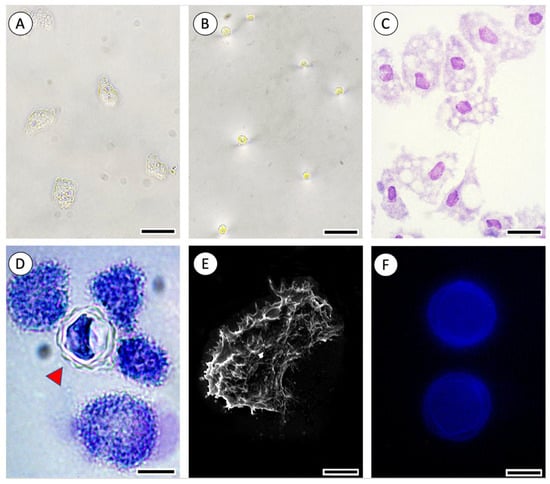
Figure 1
Open AccessArticle
Soil-Transmitted Parasites and Non-Pathogenic Nematodes in Different Regions of Porto Alegre City, Brazil: A Comparison between Winter and Summer
by
Marina Ziliotto, Joel Henrique Ellwanger and José Artur Bogo Chies
Parasitologia 2024, 4(1), 1-14; https://doi.org/10.3390/parasitologia4010001 - 21 Dec 2023
Cited by 1
Abstract
►▼
Show Figures
We assessed the prevalence of soil-associated parasites and non-pathogenic nematodes in eight public areas of Porto Alegre (Rio Grande do Sul state, southern Brazil), the most populous city in Rio Grande do Sul. Soil samplings were carried out during the winter of 2022
[...] Read more.
We assessed the prevalence of soil-associated parasites and non-pathogenic nematodes in eight public areas of Porto Alegre (Rio Grande do Sul state, southern Brazil), the most populous city in Rio Grande do Sul. Soil samplings were carried out during the winter of 2022 and summer of 2023: A total of 80 samples were collected in winter and 80 in summer (ten samples from each sampling site per season), totaling 160 soil samples. The frequency of microscopic non-pathogenic nematode larvae was significantly higher (p = 0.048) in winter (93.75%) than in summer (82.50%). Considering the pooled data from winter and summer (n = 160) for human pathogenic parasites, the following frequencies were observed (using microscopy analysis): hookworm (filariform) larvae (1.25%), hookworm (rhabditiform) larvae (11.25%), Strongyloides spp. (filariform) larvae (0.63%), Strongyloides spp. (rhabditiform) larvae (2.5%), hookworm eggs (10.63%), Ascaris spp. eggs (10.00%), and Trichuris spp. eggs (1.25%). Hookworm (rhabditiform) larvae were the most frequent parasitic structures (15.00%) in winter, and A. lumbricoides eggs were the most frequent parasitic structures (8.75%) in summer. No statistically significant difference was observed in the frequency of pathogenic parasites between the seasons (p > 0.05). Toxoplasma gondii DNA was assessed, but all soil samples tested negative in molecular analysis. Our results indicate that soil from many regions of Porto Alegre shows a high prevalence of soil-transmitted helminths, indicating the need for improvements in social conditions and environmental sanitation in the city. Our study also suggests that climate change may affect soil biodiversity, potentially harming non-pathogenic nematodes and favoring human pathogenic parasites.
Full article
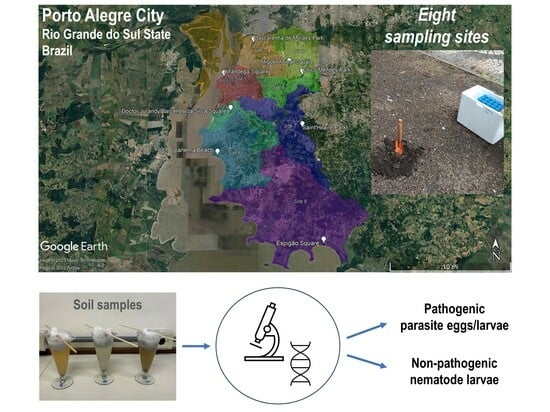
Graphical abstract
Open AccessReview
Toxoplasma gondii in Marine Life of Italian Coasts, What Do We Know So Far?
by
Veronica Rodriguez-Fernandez and Fabrizio Bruschi
Parasitologia 2023, 3(4), 364-373; https://doi.org/10.3390/parasitologia3040035 - 05 Dec 2023
Abstract
►▼
Show Figures
Coastal areas of Italy experience high anthropogenic pressure, with a population density estimated to be 360 people per km2. This is correlated with the production of sewage or surface runoff of water contaminated with Toxoplasma gondii oocysts and other pathogens that
[...] Read more.
Coastal areas of Italy experience high anthropogenic pressure, with a population density estimated to be 360 people per km2. This is correlated with the production of sewage or surface runoff of water contaminated with Toxoplasma gondii oocysts and other pathogens that can in turn enter the food chain and become a public health concern. Therefore, in the present study, we want to review the current knowledge on the presence of T. gondii in Italian coastal areas. The majority of research in Italy has been carried out on marine mammals, while fishes and mollusks have less often been screened. So far, T. gondii has been found in all sea animals tested, with genotypes II and III as well as atypical genotypes being the most commonly found when screened. However, more information is needed. We encourage routine screening of mollusks and fish that are sold in different food markets throughout the country in order to add information on the distribution of T. gondii and other parasites, preventing possible future outbreaks.
Full article
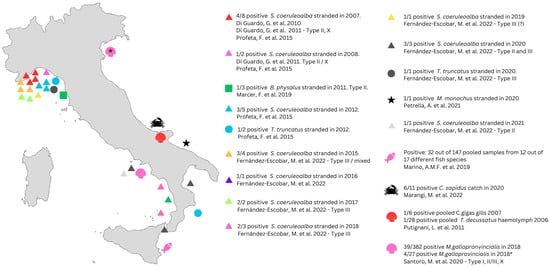
Figure 1
Open AccessArticle
Discovery of Antigens and Cellular Mechanisms in the Protozoan Parasite Sarcocystis aucheniae Using Immunoproteomics
by
Sarah Nathaly Wieser, Cecilia Decker-Franco, Paloma de Alba, Sandra Romero, Alejandro Ferrari, Leonhard Schnittger and Mónica Florin-Christensen
Parasitologia 2023, 3(4), 349-363; https://doi.org/10.3390/parasitologia3040034 - 26 Nov 2023
Cited by 1
Abstract
Sarcocystis aucheniae is a coccidian parasite that produces macroscopic sarcocysts in South American camelid (SAC) muscles and causes a disease known as SAC sarcocystosis. This parasitosis hampers the commercialization of llama and alpaca meat, a vital economic activity in the Andean regions. No
[...] Read more.
Sarcocystis aucheniae is a coccidian parasite that produces macroscopic sarcocysts in South American camelid (SAC) muscles and causes a disease known as SAC sarcocystosis. This parasitosis hampers the commercialization of llama and alpaca meat, a vital economic activity in the Andean regions. No control or prevention methods are available, and diagnosis is based on postmortem visual inspection of carcasses. The aim of this study was to identify S. aucheniae B-cell epitopes suitable for the development of diagnostic methods for SAC sarcocystosis. To this end, sarcocyst immunoreactive protein bands were analyzed via mass spectrometry, and proteins in each band were identified in silico by searching in the parasite transcriptome. Five highly antigenic, hydrophilic B-cell epitopes, predicted not to cross-react with antibodies against other coccidia, were selected for future development of peptide-based serological tests. In addition, conserved domains present in the identified proteins allowed us to unravel metabolic pathways and mechanisms active in the parasitic stages present in sarcocysts, including aerobic respiration, antioxidant activity, signal transduction, protein synthesis and processing, and host–pathogen interactions. This study provides novel information on the biology of S. aucheniae, as well as new protein sequences that can be used for the development of diagnostic tests and chemotherapeutic approaches for SAC sarcocystosis.
Full article
(This article belongs to the Special Issue Sarcocystis in Domestic and Wildlife Animals)
►▼
Show Figures
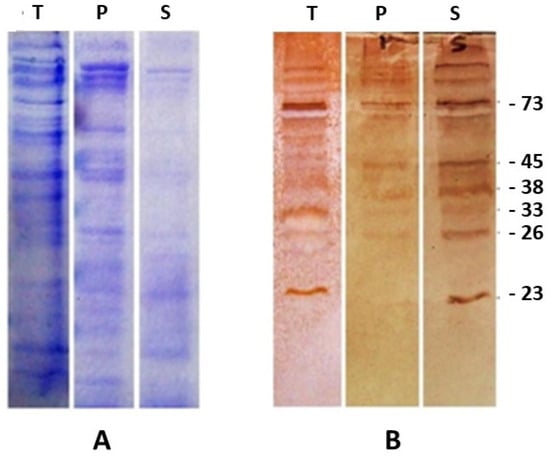
Figure 1
Open AccessCorrection
Correction: Solano-Barquero et al. Metazoan Marine Parasites of Costa Rica: A Review. Parasitologia 2023, 3, 116–141
by
Alberto Solano-Barquero, Alicia Rojas and Jorge Cortés
Parasitologia 2023, 3(4), 348; https://doi.org/10.3390/parasitologia3040033 - 20 Nov 2023
Abstract
There was a small error in the fifth sentence of the Abstract in the original publication [...]
Full article
Open AccessReview
Sarcocystis Species (Apicomplexa, Eucoccidiorida) Parasitizing Snakes
by
Taynar Lima Bezerra, Rodrigo Martins Soares and Luís Fernando Pita Gondim
Parasitologia 2023, 3(4), 327-347; https://doi.org/10.3390/parasitologia3040032 - 10 Nov 2023
Abstract
The genus Sarcocystis has approximately 200 species that are able to infect homeothermic and poikilothermic animals. So far, 23 Sarcocystis spp. have snakes as definitive hosts (DHs) and mammals and/or reptiles as intermediate hosts (IHs). Some of these species cause disease or even
[...] Read more.
The genus Sarcocystis has approximately 200 species that are able to infect homeothermic and poikilothermic animals. So far, 23 Sarcocystis spp. have snakes as definitive hosts (DHs) and mammals and/or reptiles as intermediate hosts (IHs). Some of these species cause disease or even death in their IH. At least two Sarcocystis spp. from snakes have relevance in public health. Sarcocystis nesbitti causes serious myopathy in humans, and S. singaporensis is lethal for rats and was successfully tested in the biological control of these rodents. Molecular identification was not reported for half of Sarcocystis spp. shed by snakes. For some snake species, their role as DHs for Sarcocystis spp. is totally unknown, including certain snakes which are bred as companion animals. The aim of this review is to discuss the role of snakes as DHs or IHs of Sarcocystis spp. and the future directions for the identification of the parasites and the elucidation of their life cycles.
Full article
(This article belongs to the Special Issue Sarcocystis in Domestic and Wildlife Animals)
►▼
Show Figures
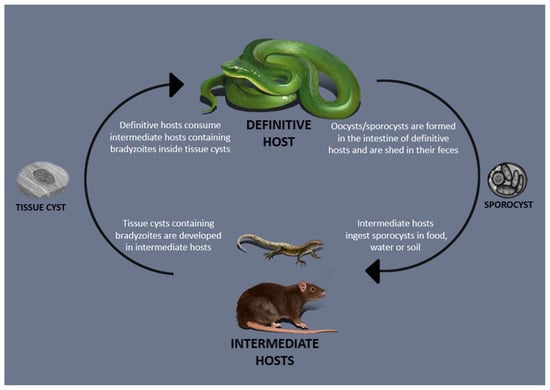
Figure 1
Open AccessReview
The Large American Liver Fluke (Fascioloides magna): A Survivor’s Journey through a Constantly Changing World
by
Ágnes Csivincsik, Tibor Halász and Gábor Nagy
Parasitologia 2023, 3(4), 300-326; https://doi.org/10.3390/parasitologia3040031 - 04 Oct 2023
Abstract
The large American liver fluke (Fascioloides magna) is considered an invasive trematode parasite in Europe. Its origin dates back before the Cretaceous-Paleogene Mass Extinction, after which it survived at least three population bottlenecks and successful host switches before it arrived in
[...] Read more.
The large American liver fluke (Fascioloides magna) is considered an invasive trematode parasite in Europe. Its origin dates back before the Cretaceous-Paleogene Mass Extinction, after which it survived at least three population bottlenecks and successful host switches before it arrived in Europe. The authors review the evolutionary history of F. magna, the distribution by its ancient proboscidean hosts, and the probable drivers of the switch to the white-tailed deer (Odocoileus virginianus). The review collects knowledge on the biology of intermediate hosts, which helps understand the factors that influence the epidemiology of F. magna in aquatic ecosystems. The authors demonstrate the adaptation potential of the parasite using data from both North American and European endemics. Finally, the study calls attention to the epidemiological risk of human-induced global change, with a special interest in the invasive snail species Pseudosuccinea columella.
Full article
(This article belongs to the Special Issue Global Change and Parasites)
►▼
Show Figures
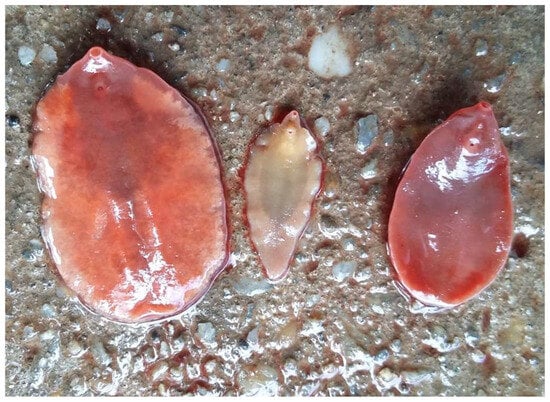
Figure 1
Open AccessCommunication
Prevalence and Seasonal Variation of Trichuris Worms Infection in Mastomys natalensis in Morogoro and Iringa Regions, Tanzania
by
Claus Thomas, Venance Msoffe, Natalie Van Houtte, Ginethon Mhamphi, Joachim Mariën, Christopher Sabuni, Isaac Makundi, Jahashi Nzalawahe, Robert Machang’u and Herwig Leirs
Parasitologia 2023, 3(3), 293-299; https://doi.org/10.3390/parasitologia3030030 - 16 Sep 2023
Abstract
►▼
Show Figures
Trichuriosis is a disease in mammals caused by the whipworms of the genus Trichuris. These worms are known for the high disease burden they cause in humans and domestic animals, especially in sub-Saharan Africa. In this study, we investigated the prevalence and
[...] Read more.
Trichuriosis is a disease in mammals caused by the whipworms of the genus Trichuris. These worms are known for the high disease burden they cause in humans and domestic animals, especially in sub-Saharan Africa. In this study, we investigated the prevalence and seasonal variations of Trichuris worms in multimammate rats (Mastomys natalensis). The study was conducted between January and November 2021 in Tanzania, in two regions (Morogoro and Iringa) that differ in their eco-climatic conditions. Removal trapping was conducted using Sherman® live traps during the rainy and dry seasons. The gastrointestinal tracts of captured rodents were screened for the presence of Trichuris worms, which were identified using morphological keys. A total of 200 M. natalensis rats were collected from each of the regions, with 100 animals in each season. For Morogoro, the overall prevalence of Trichuris worms in M. natalensis was 36% (n = 72), of which 42% (n = 42) and 30% (n = 30) were for the rainy and dry seasons, respectively. For Iringa, the overall prevalence was 65% (n = 130), of which there were 80% (n = 80) and 50% (n = 50) for the rainy and dry seasons, respectively. Trichuris worm infections were significantly higher during the rainy season in Iringa than in Morogoro; however, no significant difference in infections between males and females was noted in either region or season. Other helminths detected were Strongyloides spp., Capillaria spp., Hymenolepis spp. and eggs of a helminth that has yet to be confirmed, possibly an Anoplocephalid species. Since M. natalensis is the most important pest species in sub-Saharan Africa, and is a carrier of several zoonotic helminths, there is a need for improved surveillance of helminths infections in the studied regions, in order to establish strategic control programs to reduce their adverse impacts on health.
Full article
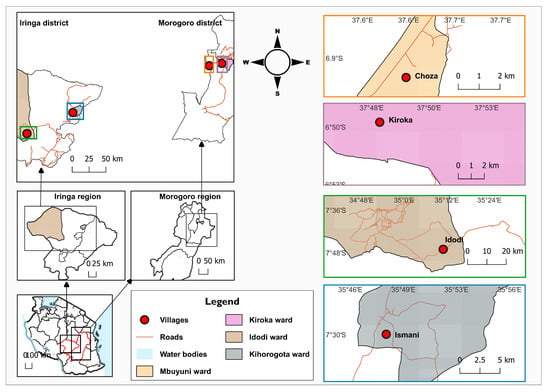
Figure 1
Open AccessArticle
Dermacentor variabilis Does Not Transstadially Transmit the U.S. Isolate of Theileria orientalis Ikeda: A Controlled Acquisition and Transmission Study
by
Cynthia K. Onzere, Amany Hassan, David R. Herndon, Kennan Oyen, Karen C. Poh, Glen A. Scoles and Lindsay M. Fry
Parasitologia 2023, 3(3), 284-292; https://doi.org/10.3390/parasitologia3030029 - 14 Sep 2023
Cited by 1
Abstract
►▼
Show Figures
Theileria orientalis Ikeda, an emerging U.S. bovine hemoparasite, causes anemia, abortion, ill-thrift, and occasionally death. While Haemaphysalis longicornis is the primary vector, it is possible that other U.S. ticks are capable of parasite transmission and may contribute to disease spread. Dermacentor variabilis is
[...] Read more.
Theileria orientalis Ikeda, an emerging U.S. bovine hemoparasite, causes anemia, abortion, ill-thrift, and occasionally death. While Haemaphysalis longicornis is the primary vector, it is possible that other U.S. ticks are capable of parasite transmission and may contribute to disease spread. Dermacentor variabilis is highly prevalent in the U.S., exhibits a similar geographical distribution to T. orientalis, and is a competent vector of the related parasite, Theileria equi. Herein, we conducted controlled acquisition and transmission studies using splenectomized calves to assess whether D. variabilis can transstadially transmit T. orientalis. D. variabilis nymphs were applied to an infected, splenectomized calf for parasite acquisition and subsequently incubated to molt into adults. Freshly molted adults were applied to two splenectomized T. orientalis-naïve calves to investigate parasite transmission. Calves were monitored for 59 days, and no evidence of parasite transmission was detected using PCR for the T. orientalis Ikeda major piroplasm surface protein gene, blood smear cytology, complete blood counts, or physical examination. Salivary glands from a subset of D. variabilis adults were assessed for T. orientalis using PCR, and the parasite was not detected. These findings support the conclusion that D. variabilis is not capable of transstadial transmission of the U.S. T. orientalis Ikeda isolate.
Full article
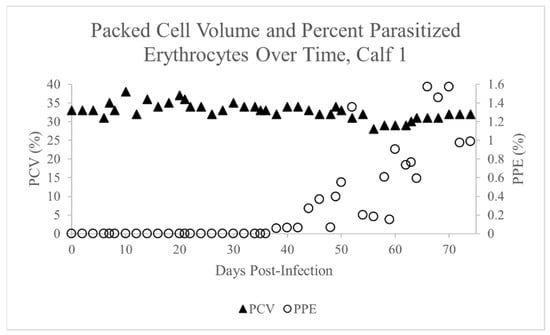
Figure 1
Open AccessReview
Current Applications of Digital PCR in Veterinary Parasitology: An Overview
by
Constantina N. Tsokana, Isaia Symeonidou, Georgios Sioutas, Athanasios I. Gelasakis and Elias Papadopoulos
Parasitologia 2023, 3(3), 269-283; https://doi.org/10.3390/parasitologia3030028 - 06 Sep 2023
Cited by 2
Abstract
Digital PCR (dPCR) is an emerging technology that enables the absolute quantification of the targeted nucleic acids. The body of research on the potential applications of this novel tool is growing in human and veterinary medicine. Most of the research on dPCR applications
[...] Read more.
Digital PCR (dPCR) is an emerging technology that enables the absolute quantification of the targeted nucleic acids. The body of research on the potential applications of this novel tool is growing in human and veterinary medicine. Most of the research on dPCR applications in veterinary parasitology is concentrated on developing and validating new assays to detect and quantify parasites of great financial impact in the food-producing animal industry. Several studies describe the utility of dPCR for individualized medicine in companion animals. Most frequently, dPCR performance is assessed compared to quantitative PCR or Next Generation Sequencing platforms, while others also compare the accuracy of dPCR with traditional parasitological techniques considered gold standard methods. Other researchers describe dPCR assays for surveillance purposes, species identification, and quantification in mixed parasitic infections, the detection of mutations indicative of anthelmintic resistance, and the identification of new targets for drug development. This review provides an overview of the studies that employed dPCR in investigating animal parasites and parasitic diseases from a veterinary perspective and discusses how this novel technology could advance and facilitate diagnosis, surveillance, and the monitoring of response to treatment, or shed light on current gaps in our knowledge of the epidemiology of significant veterinary parasitic diseases.
Full article
(This article belongs to the Special Issue The Molecular Epidemiology of Parasites)
►▼
Show Figures
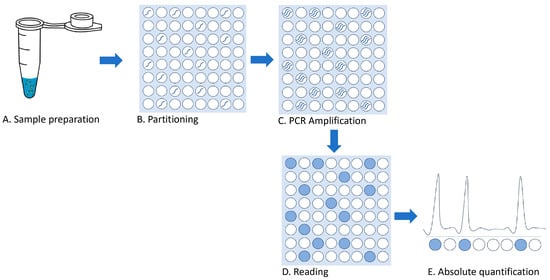
Figure 1
Open AccessSystematic Review
Worldwide Overview of Neospora spp. Infection in Equids Diagnosed by Serological Tests: Systematic Review and Meta-Analysis
by
Paulo Wbiratan Lopes Costa, Felipe Boniedj Ventura Alvares, Hosaneide Gomes Araújo, Clécio Henrique Limeira, Fabio Ribeiro Braga, Thais Ferreira Feitosa and Vinícius Longo Ribeiro Vilela
Parasitologia 2023, 3(3), 260-268; https://doi.org/10.3390/parasitologia3030027 - 01 Sep 2023
Abstract
►▼
Show Figures
Equids can be infected by Neospora spp., and its infection is associated with neurological and reproductive disorders. This systematic review and meta-analysis aimed to assess the prevalence of anti-Neospora caninum antibodies in horses, donkeys and mules worldwide between 2012 and 2022. Five
[...] Read more.
Equids can be infected by Neospora spp., and its infection is associated with neurological and reproductive disorders. This systematic review and meta-analysis aimed to assess the prevalence of anti-Neospora caninum antibodies in horses, donkeys and mules worldwide between 2012 and 2022. Five scientific databases were consulted: MEDLINE, ScienceDirect, PubMed, LILACS and SciELO, using the descriptors “protozoan” or “neospora” AND “horses” or “donkeys” or “mules”. A total of 1909 studies were screened, and 25 studies met the inclusion criteria. The pooled prevalence of Neospora spp. infection in equids, based on a total of 11,076, was 8.34% (95% CI: 4.78–14.17%). Further analysis by species revealed no statistically significant difference in the prevalence of Neospora spp. infection across equids: 8.5% (95% CI 5.03–13.99%) in horses, 7.36% (CI 2.08–22.94%) in donkeys and 6.07% (95% CI 0.71–36.83%) in mules. Regarding diagnostic tests, the prevalence of Neospora spp. infection determined by the indirect fluorescent antibody test (IFAT) was 8.08% (95% CI: 3.74–16.61%), by the enzyme-linked immunosorbent assay (ELISA) was 7.91% (95% CI: 3.71–16.08%), and by the modified agglutination test (MAT) was 20% (95% CI: 15.37–25.60%). This meta-analysis provided valuable and comprehensive insights into the prevalence of Neospora spp. infection in horses, donkeys, and mules using serological detection methods. The results highlight the wide distribution of Neospora spp. infection in equids across all continents, indicating the importance of this infection. Transmission of the parasite can occur both horizontally (directly between animals) and vertically (from mother to offspring), further emphasizing the significance of understanding and managing this infection in equid populations.
Full article
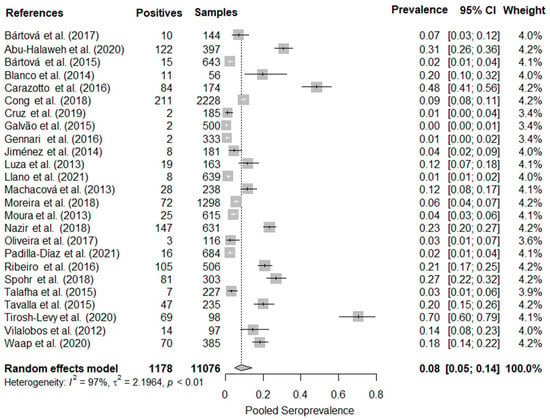
Figure 1
Highly Accessed Articles
Latest Books
E-Mail Alert
News
Topics

Conferences
Special Issues
Special Issue in
Parasitologia
The Molecular Epidemiology of Parasites
Guest Editor: Geoff HideDeadline: 31 May 2024






